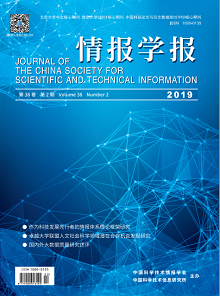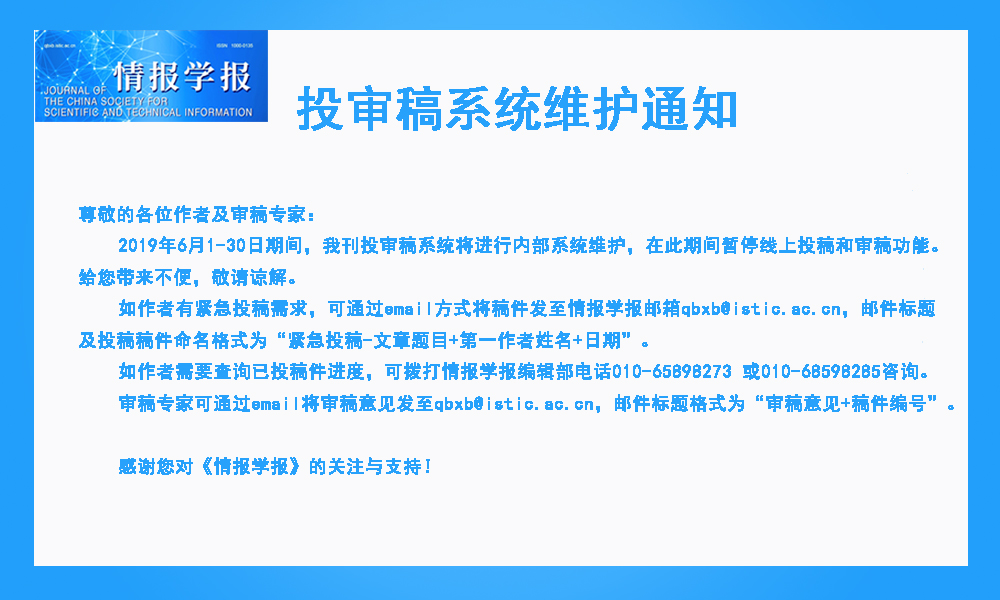 |
|
2019 Vol. 38, No. 2
Published: 2019-02-28 |
|
|
| |
|
|
|
|
|
121 |
Research on the Scientific Research Level of the Excellence 9 League in the Field of Opportunity Discovery of Cooperation in the Humanities and Social Sciences |
|
 |
Lin Yuan, Li Luying, Xu Kan, Liu Shengbo |
|
|
DOI: 10.3772/j.issn.1000-0135.2019.02.002 |
|
|
The development of a high level of humanities and social sciences points toward the direction of breakthroughs in the construction of first-rate universities and world-renowned high-level universities in the field of science and engineering. By statistically analyzing the basis for cooperation in scientific research in universities of science and engineering, high-efficiency potential cooperation opportunities are discovered. Our country??s “Excellent 9” league is taken as an example, based on the three cooperative basic indicators of joint cooperation institutions, discipline distribution, and keywords, to analyze the motivation of cooperation and explore potential cooperation directions for universities. At the same time, a similarity measure based on the information vector of a university is proposed, and the difference of information between colleges is compared and analyzed; thus, potential cooperation is suggested. The combination of quantitative analysis and vector representation reveals the potential cooperation direction of five pairs of universities and provides a feasible information representation model for mining potential cooperation opportunities in colleges and universities, which can be used to guide the development of scientific research. |
|
|
2019 Vol. 38 (2): 121-131
[Abstract]
(
207
)
HTML
(163 KB)
PDF
(1114 KB)
(
915
) |
|
|
|
132 |
Information Service Quality of Online Health Platform Based on User Participation |
|
 |
Qian Minghui, Xu Zhixuan, Wang Shan |
|
|
DOI: 10.3772/j.issn.1000-0135.2019.02.003 |
|
|
Based on the SERQUAL and E-SERQUAL evaluation models, this study investigates the uneven distribution of the information service quality of online health platforms in China, constructing an evaluation index system for the information service quality of China's online health platforms from the six dimensions of information service efficiency, ease of use of the information service, protection of private information, comprehensiveness of the information service, contact, and responsiveness; then, the research builds a model between information service quality and user participation and further explores the relationship between information service quality and user participation through an empirical study, which provides a reference for the standardization of information service quality and promotion of user participation in China's online health platform. |
|
|
2019 Vol. 38 (2): 132-142
[Abstract]
(
316
)
HTML
(158 KB)
PDF
(729 KB)
(
2044
) |
|
|
|
159 |
The Novelty Evaluation of Articles on WeChat Subscription Based on Recursive Neural Tensor Network |
|
 |
Wang Ping, Hou Jingrui, Wu Renli |
|
|
DOI: 10.3772/j.issn.1000-0135.2019.02.005 |
|
|
The problem of content homogeneity in We-Media platforms is becoming increasingly serious, making it difficult for users to obtain high-quality information. Therefore, it is particularly important to evaluate the novelty of We-Media articles. Taking the articles of WeChat Subscription as an example, this paper proposes a novelty evaluation method for articles on We-Media platforms, using an unsupervised sentence level Doc2Vec language model to construct the text vector, and establishes a novelty evaluation model to quantify articles’ novelty based on the recursive neural tensor network. This paper automatically collected 4,628 articles from WeChat Subscription to conduct an empirical research. First, a number of different tensor slices were selected to conduct contrastive experiments, and the optimal parameters were obtained by combining the feature of novelty distribution and training time. Subsequently, the linear regression relationship between novelty and similarity was discovered and then verified by calculating the similarity of the documents. The experimental results demonstrate the feasibility and effectiveness of this approach. This paper expands and enriches the research on document novelty evaluation from the perspective of deep learning. It also supports the novel topic detection and frontier knowledge discovery of We-Media platforms. |
|
|
2019 Vol. 38 (2): 159-169
[Abstract]
(
286
)
HTML
(190 KB)
PDF
(3058 KB)
(
968
) |
|
|
|
191 |
Named Entity Recognition Using Linked Data |
|
 |
Liu Xiaojuan, Liu Qun, Yu Mengxia |
|
|
DOI: 10.3772/j.issn.1000-0135.2019.02.008 |
|
|
Named Entity Recognition (NER) is a basic task in the field of Natural Language Processing with generalized applications. Because of plentiful semantic knowledge, Linked Data can improve the performance of NER. This paper realizes a configurable NER System called NERULD (Named Entity Recognition Using Linked Data) that can support Chinese and English texts and is based on Linked Data in order to disambiguate the recognized entities and to extend the results of NER, so that a new idea to improve the performance of NER can be provided. This study was conducted as follows. We first built a cross-domain Chinese named entity dictionary and English named entity dictionary using the DBpedia dataset. We then designed a distributed model based on Hive and Hadoop to organize, store, and extend Linked Data. We developed a graph-based algorithm to recognize and disambiguate named entities, which can make full use of the semantic relationships of Linked Data. We also tested our algorithm using the DBpedia Spotlight NER Corpus, and compared our result with DBpedia Spotlight, NERSO, and Zemanta, and found that the algorithm implemented in this paper has better performance in recall, precision, and F value. |
|
|
2019 Vol. 38 (2): 191-200
[Abstract]
(
255
)
HTML
(89 KB)
PDF
(12056 KB)
(
448
) |
|
|
|
217 |
Review of Domestic and International Research on Big Data Quality |
|
 |
Liu Bing, Pang Lin |
|
|
DOI: 10.3772/j.issn.1000-0135.2019.02.011 |
|
|
As a frontier research field, big data quality research is one of the core contents of big data research; it is also the focus of attention from all walks of life. Based on the literature on big data quality, this paper uses synthesis methods to examine the progress of relevant domestic and international research in terms of its basic implications, quality management, quality evaluation, and application practice. The results show that the study of big data quality is based on big data characteristics, with the basic attributes of big data quality as the core, combined with its application goals and applicable scenarios. It finally forms a complex and multidimensional theoretical system that is different from the conventional data quality theory. At the same time, the results indicate that the study of the essence of big data quality, the combination of technical and human environment, and research on the national and strategic levels based on a macro perspective will be the future research trends and research focus of big data quality research. |
|
|
2019 Vol. 38 (2): 217-226
[Abstract]
(
213
)
HTML
(188 KB)
PDF
(693 KB)
(
2918
) |
|
|
|


